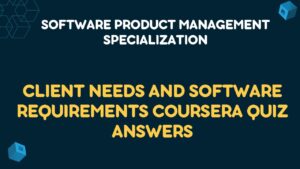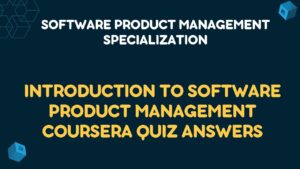Table of Contents
Create High-Fidelity Designs and Prototypes in Figma Week 1 Quiz Answers
Optional – Test your knowledge of prior concepts Quiz Answers
Q1. What are some key benefits of considering accessibility in UX design? Select all that apply.
- Creates solutions that often help everyone
- Addresses societal structures and products rather than a person’s ability
- Ensures underrepresented and excluded groups are taken into account
- Addresses a11y ideas
Q2. Which phase of the design sprint helps the team find solutions to build on?
- Understand
- Decide
- Ideate
- Test
- Prototype
Q3. What can a researcher learn when they properly empathize with users during user research?
- The opinions, feelings, and biases of their users
- The needs, behaviors, and motivations of their users
- The wants, desires, and fears of their users
- The hopes, dreams, and assumptions of their users
Q4. Which of the following are examples of pain points?
- Receiving the same response to three different questions from an automated chatbot
- Struggling to interact with a button on a mobile app’s homepage because it’s extremely small
- Being asked to submit credit card information when no payment is required
- Completing the checkout process for a food delivery app
Q5. You are designing a life-coaching app for people between the ages of 21 and 30. After conducting research with a diverse set of users, you discover that established professionals are three times more likely to use life-coaching services than those at the beginning of their careers. Which of the following is an example of a complete user persona for your user group?
- Nistha Dube, a 29-year-old engineer and foodie from Chennai, India, who makes viral cooking videos on the weekends. Nistha has been thinking about how to balance their career and their passion for food, but they also want to make more time for their mental health in their schedule.
- Rita Dieguez, a 24-year-old who identifies as non-binary from Manaus, Brazil.
- Michael Embery, a 22-year-old from Indianapolis, Indiana who has a busy work schedule.
- Liz Fontaine, a 27-year-old veterinarian who enjoys video games
Q6. Which of the following user stories is complete?
- As a chef, I want access to the freshest ingredients and the highest-quality cooking utensils.
- As a scientist, I want access to my colleagues’ published research.
- I want a bookshelf so I have somewhere to store my book collection.
- As a yoga instructor, I want to create a consistent class schedule so that my clients know how to confidently plan their weekly exercise.
Q7. Fill in the blank: Designing products with accessibility and inclusivity in mind ensures that you _____.
- create an identical experience for all users
- focus on creating one solution for as many people as possible
- include solutions that benefit specific individuals, which improves the user experience for all users.
- create a different solution for every single user.
Q8. Which of the following is a complete problem statement?
- Angelo needs a toolbox and shingles to fix the leak in their roof.
- Hakim is an accountant who needs to collect expense reports from their coworkers.
- Akiko is a construction consultant who is building a skyscraper.
- Bella is a dance choreographer who needs to create a practice video because some of their students have school during the day and can’t attend lessons in person.
Q9. Identify the steps of the ideation process in the correct order.
- Gathering a diverse team, brainstorming, documenting ideas, questioning obvious solutions, focusing on quantity, and evaluating the ideas.
- Brainstorming, documenting ideas, focusing on quantity, gathering a diverse team, questioning obvious solutions, and evaluating the ideas.
- Documenting ideas, brainstorming, focusing on quantity, questioning obvious solutions, gathering a diverse team, and evaluating the ideas.
Q10. You’re a UX designer working on a gaming app in a competitive market space. You want to figure out what your competitors’ strengths and weaknesses are, and how to create a better product. What should you do?
- Contact each company directly
- Conduct informal research online
- Create a marketing plan
- Conduct a competitive audit
Q11. Which of the following scenarios would be most appropriate to use a close-up storyboard?
- You are in the middle of the design process for a grocery delivery app. You want to pitch some ideas to the team about how the user could use it and benefit from it.
- You begin creating a new finance management app. You need to demonstrate when and how a user might interact with it during a normal work day.
- You create an app that connects people who are interested in gardening via a social forum. You want to implement an inbox feature and test whether or not users find it easy to use.
Q12. Which of the following UX tools and processes demonstrates the basic structure and layout of a design without including specific visual details?
- High-fidelity designs
- Wireframes
- Ideation exercises
- Low-fidelity designs
Q13. You are working on an app that connects users to tree removal services in their local area. You have already created paper wireframes and now it’s time to build the design on the computer. What is the next step?
- Create high-fidelity mockups
- Create a high-fidelity prototype
- Create digital wireframes
- Create a low-fidelity prototype
Q14. How is a prototype different from a wireframe?
- Wireframes and prototypes are both interactive representations of how a design works.
- A prototype is a single screen that shows all the details that will go into a final design. A wireframe is a set of interactive design solutions made up of many prototypes and demonstrates how the entire design works.
- A prototype is an interactive representation of a complete design solution that shows stakeholders how it will work. A wireframe is a single screen with basic elements that establishes the structure of a page.
- A wireframe is an interactive representation of a complete design solution that shows stakeholders how it will work. A prototype is a single screen with basic elements that establishes the structure of a page.
Q15. Identify the benefit of using paper prototypes in the design process
- Paper prototypes are polished and represent a final design solution
- Paper prototypes are inexpensive and convey complex visual details
- Paper prototypes require large amounts of time and resources to produce
- Paper prototypes allow rapid iterations and require low commitment
Q16. Fill in the blank: _____ is the collection of attitudes and stereotypes we associate to people without our conscious knowledge.
- Recency bias
- Sunk cost fallacy
- Primacy bias
- Implicit bias
Q17. Which of the following is an example of a usability study?
- Arthur recruits participants for a study, gives them specific tasks, and asks them how difficult each task was to complete afterwards
- Darla recruits participants for a study, gives them specific tasks, and asks them for only positive feedback about each task
- Daryl presents their prototype to several strangers on the street and asks them to see how they like using it
- Marlene has each stakeholder review their design before handing it off to the development team
Q18. A moderator conducts a usability study to solicit feedback on a mileage tracking feature for a cycling app. Which type of bias may occur if the participant gives multiple pieces of feedback in the same answer?
- Implicit bias
- Friendliness bias
- Social desirability bias
- Serial position effect
Q19. You are a UX researcher who just finished the research for an app that helps users find speciality coffee brands. You’ve gathered all of the observations from your interviews and identified the common themes. What comes next?
- Organize your data using an affinity diagram
- Write down insights based on the themes you’ve identified
- Propose solutions to the common themes you’ve identified
- Evaluate the themes to determine which observations to disregard
Q20. Strong insights uncovered in research should be easy to understand, answer the research question, and increase empathy for the user.
- True
- False
Q21. What types of content should be included in your presentation slide deck when presenting UX research insights to stakeholders?
- User stories, user flows, user journeys, and pain points
- Themes, insights and recommendations, and details about the study
- Affinity maps, research methods, research questions, and key performance indicators (KPIs)
Test your knowledge of typography Quiz Answers
Q1. A _____ is the size, thickness, and emphasis of letters.
- sans serif
- font
- typeface
- serif
Q2. Which of the following is an example of a typeface name?
- Normal
- Underline
- Arial
- Heading
Q3. What are the benefits of good typography? Select all that apply.
- Typography makes text easier to read.
- Typography demonstrates brand guidelines.
- Typography adds hierarchy to help readers navigate a page better.
- Typography limits wasted text space.
Test your knowledge on color Quiz Answers
Q1. In the 60-30-10 rule for design, which color characteristic makes up 10% of the palette?
- Primary color
- Accent color
- Neutral color
- Complementary color
Q2. A design team builds a site for a travel company and wants to incorporate vibrant colors into the design. The team consults the _____ to ensure the colors they select follow contrast guidelines and maintain accessibility.
- Web Content Accessibility Guidelines
- hex code
- 60-30-10 rule
- color code
Q3. Why is color an important factor in designing your product? Select all that apply.
- Color draws the attention of the user.
- Color helps the user effectively navigate the design.
- Color allows the designer to introduce their personal preferences into the design.
- Color can convey emotions for the user.
Q4. Luanne is an American, but she’s designing a food delivery mobile app for a client that is based in Peru. Luanne uses green as an accent color to represent prosperity. Her client criticizes the design’s color scheme because the color green has negative connotations in Peru. What could Luanne have done differently? Select all that apply.
- Perform regional research on color.
- Contact the client prior to choosing colors.
- Conduct competitive research into other apps used by the target market.
- Send the design directly to the engineering team.
Create High-Fidelity Designs and Prototypes in Figma Week 2 Quiz Answers
Q1. A designer develops a website for a local bakery and wants to direct users to its online ordering page. They add a bright orange “Place an Order” button to the homepage with a white background. What visual weight variable did the designer incorporate in the app?
- Color
- Motion
- Size
- Image
Q2. When deciding what to emphasize in your design, what key questions should you ask? Select all that apply.
- Where do I want to draw the user’s attention?
- Where should I place the secondary sections?
- How frequently should I include the emphasis?
- What are the user’s goals?
Q3. Hierarchy is important in UX design because it makes clear to the user _____ and what action to take.
- what needs the least attention
- where to find the homepage
- what is least important
- where to focus first
Q4. Which of the following is an example of hierarchy?
- A website’s homepage adds bold color to the heading text
- A website’s homepage that opens up with a large image at the top and, as users scroll down the page, the other like images gradually become smaller.
- A website’s navigation bar alternates between different colors for each subject
- A website that features a consistent color scheme
Test your knowledge on scale and proportion Quiz Answers
Q1. Which visual design principle is used to explain the size relationship between a given element and the other elements in a design?
- Containment
- Scale
- Proportion
- Emphasis
Q2. If a designer reviews the navigation bar on a mockup and considers replacing one of the five icons, which visual design elements will best help them keep the design consistent and balanced? Select all that apply.
- Emphasis
- Scale
- Proportion
- Hierarchy
Q3. Fill in the blank: If one element in your proportionate design increases in size, then the other elements should _____.
- stay the same size so the original elements stay proportionate
- also increase in size at the same rate in order to remain proportionate
- shrink in size to place emphasis on the resized element
- move in the design to prevent any potential crowding
Test your knowledge of Gestalt Principles Quiz Answers
Q1. Which Gestalt Principle states that elements that are close together appear to be more related compared to elements spaced farther apart?
- Common region
- Proximity
- Similarity
Q2. Consider the following scenario:
Emile is creating an app that lets people rent bicycles. Users can check-in, check out, and pay for their rental with it. Emile wants users to associate the brand color—vermillion red—with the check-out process by indicating successful progress with checkmarks in this color. Emile wants to make buttons, such as “Next” and “Complete Order” to follow the same theme. Which Gestalt principle is this comparable to?
- Similarity
- Common region
- Proximity
- Visual balance
Q3. A design team wants to add a new, secret page on their app that only keen users will be able to find. Which visual design change can they apply to adjust one element of the current design that enables users to find the secret page?
- Symmetry
- Asymmetry
- Common region
- Proximity
Create High-Fidelity Designs and Prototypes in Figma Coursera Course Review:
In our experience, we suggest you enroll in Create High-Fidelity Designs and Prototypes in Figma courses and gain some new skills from Professionals completely free and we assure you will be worth it.
Create High-Fidelity Designs and Prototypes in Figma course is available on Coursera for free, if you are stuck anywhere between quiz or graded assessment quiz, just visit Networking Funda to get Create High-Fidelity Designs and Prototypes in Figma Quiz Answers.
Get Google UX Design Professional Certificate Course Quiz Answers
Foundations of User Experience (UX) Design Quiz Answers
Start the UX Design Process: Empathize, Define, and Ideate Quiz Answers
Build Wireframes and Low-Fidelity Prototypes Quiz Answers
Conduct UX Research and Test Early Concepts Quiz Answers
Create High-Fidelity Designs and Prototypes in Figma Quiz Answers
Responsive Web Design in Adobe XD Quiz Answers
Design a User Experience for Social Good & Prepare for Jobs Quiz Answers





Can you Please upload complete other week’s answers?
Sure, We are Working on it